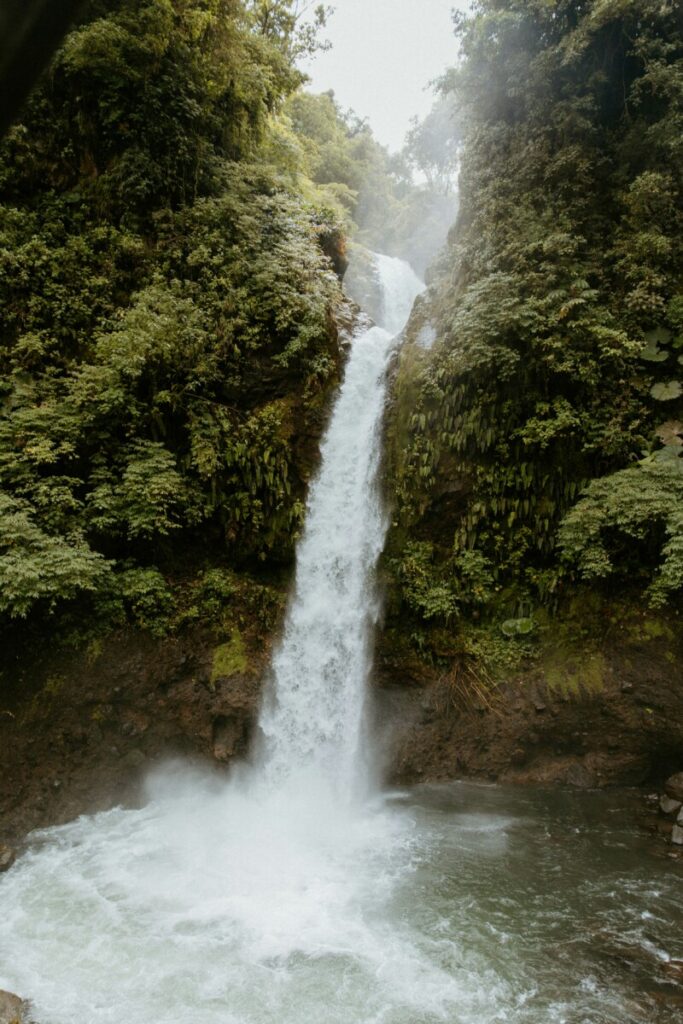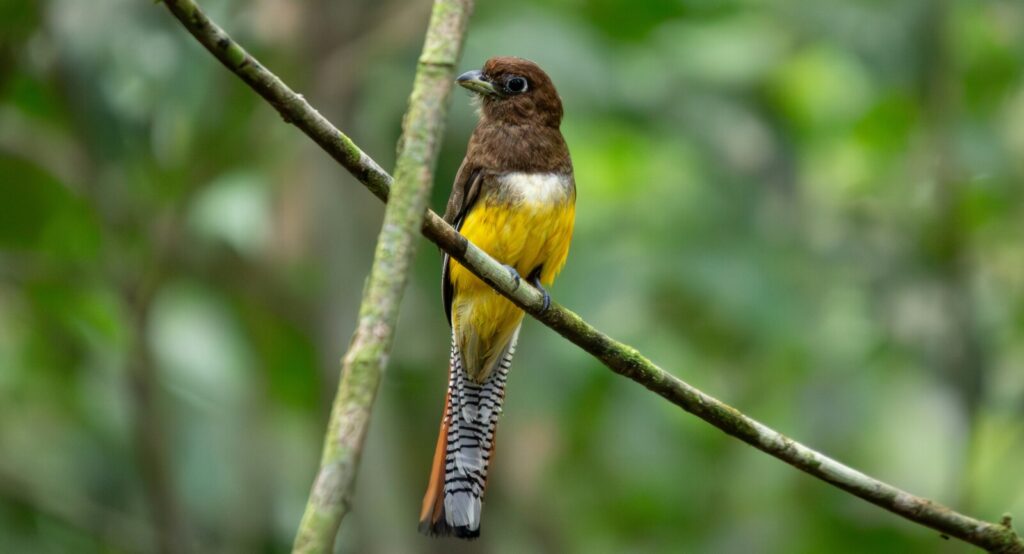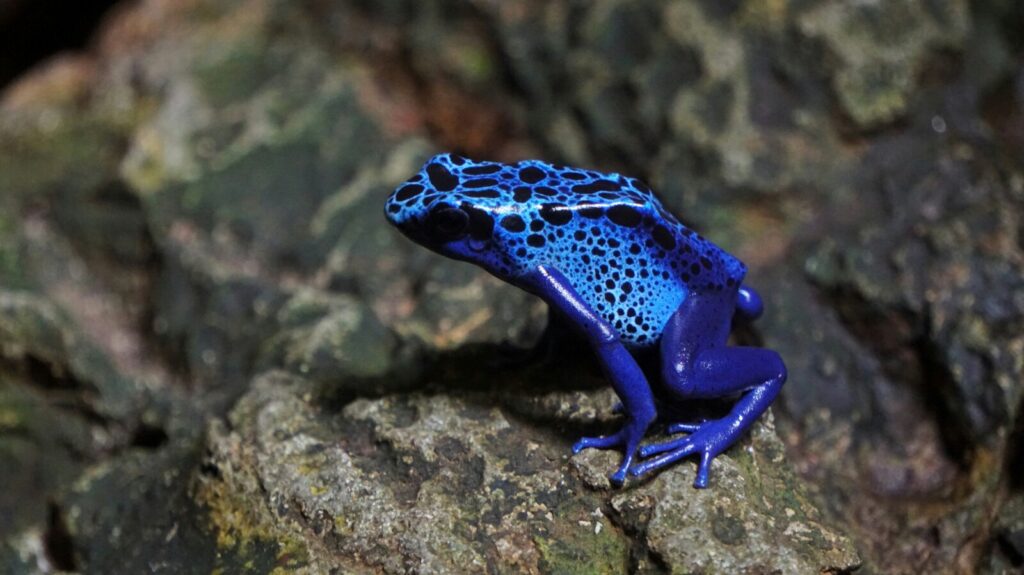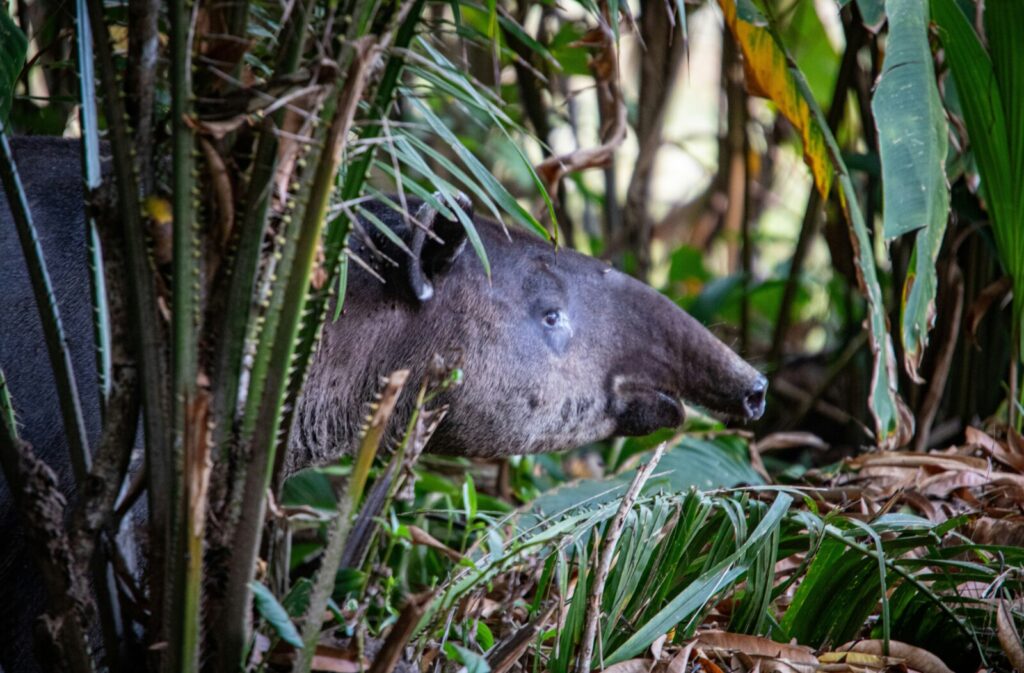Last week on the blog, we shared the first part about the animals you might encounter if you choose Costa Rica as your destination for an unforgettable volunteering experience.
Costa Rica has much to offer, and its varied landscapes contribute to its rich and diverse biodiversity. In fact, many people travel there specifically to explore it.

In this second part, we’ll discuss other popular animals that you might also come across if you’re lucky.
BIRDS
- Quetzal:
The quetzal is an iconic bird, particularly known for its iridescent green and red plumage. Its full name is the resplendent quetzal.
Its feathers are metallic green on the head, back, and wings, with a bright red chest. During mating season, the male grows long tail feathers that can extend beyond its body. It lives in cloud forests in the mountains, at altitudes between 1,000 and 3,000 meters, preferring areas with dense vegetation. Its diet consists mainly of fruits, especially small avocados, but it also eats insects, frogs, and small reptiles.
In Mesoamerican culture, the quetzal is a symbol of freedom and beauty. Although not critically endangered, it is considered near-threatened due to habitat loss.
The quetzal holds a prominent place in the folklore and mythology of pre-Columbian civilizations, particularly in Mayan and Aztec cultures, where it was considered sacred.
- Scarlet Macaw:
Also known as the “lapa roja” in some countries, it is one of the most impressive and colorful birds in Costa Rica’s tropical forests. It is famous for its brilliant plumage and large size and is one of the region’s most iconic species.
Its body is primarily bright red, with yellow and blue details on its wings. Its face is white and featherless. It can measure between 80 and 90 centimeters long, including its long tail, with a wingspan of over a meter. It lives in tropical forests and prefers humid jungles with an abundance of large trees for nesting. Its diet mainly consists of fruits, seeds, nuts, and berries, as well as flowers and, occasionally, clay from cliffs to neutralize toxins from some fruits.
It is a social bird that usually lives in pairs or small groups. They are known for their loud calls and their ability to mimic sounds. Although still found in several regions, the scarlet macaw is endangered due to habitat destruction and the illegal exotic pet trade.
In many indigenous cultures, the scarlet macaw is seen as a symbol of power, beauty, and energy. Its vibrant colors are often associated with the sun.
- Toucans:
The toucan is one of the most emblematic animals due to its impressive beak and colorful plumage.
The toucan’s beak is notably large and colorful, allowing it to reach fruits on distant branches. Despite its size, the beak is relatively lightweight, made of a keratin structure. Its vibrant plumage usually displays combinations of black, yellow, orange, and green, depending on the species.
Several toucan species can be found in Costa Rica, with the most common being:
- Keel-billed toucan: Known for its large, colorful beak, it has a black body and a yellow chest.
- Chestnut-mandibled toucan: Similar to the keel-billed, but larger and with more uniform plumage.
Toucans inhabit tropical and subtropical forests, especially in areas with abundant fruit, as their diet primarily consists of fruit. They also eat insects and small reptiles. Toucans are social birds and can often be seen in small groups. They nest in tree cavities, laying 2 to 4 eggs.
Toucans play an important role in seed dispersal, as they consume fruit and excrete the seeds in different locations, aiding forest regeneration. Although not immediately endangered, their habitat is threatened by deforestation.
- Hummingbirds:
Hummingbirds are fascinating and colorful birds known for their small size and unique flight abilities.
They are among the smallest birds in the world, ranging from 3 to 5 cm in length. Their long, slender beaks allow them to feed on flower nectar. The shape of the beak varies depending on the species and their diet. They have brilliant, metallic plumage that can include greens, blues, reds, and yellows, making them visually stunning.
Costa Rica is home to over 50 species of hummingbirds. Some of the most common include:
- Common hummingbird: One of the best-known, with iridescent plumage.
- Spatula-tailed hummingbird: Known for its spatula-shaped tail and colorful plumage.
- Speckled hummingbird: Featuring a distinctive green and blue sheen, it is common in mountainous areas.
Their diet mainly consists of flower nectar, but they also consume small insects and spiders for protein. Hummingbirds are capable of flying backward and hovering in place, thanks to their rapid wingbeats, which can reach up to 80 times per second. Males are very territorial and defend their feeding areas from other hummingbirds. They build small, delicate nests, usually cup-shaped, using materials like spider webs and feathers. The female lays 1 to 3 eggs, which she incubates alone for about two weeks.
Hummingbirds play a crucial role in pollinating many plants, as they transfer pollen from one flower to another while feeding on nectar, aiding in the reproduction of various plant species. While not generally endangered, some species may be threatened by habitat loss.

REPTILES AND AMPHIBIANS
- Iguanas:
Iguanas are fascinating reptiles commonly found in tropical and subtropical areas.
Iguanas vary in size, with the green iguana (Iguana iguana) being the largest, reaching lengths of up to 2 meters. Generally, they have a vibrant green color, although they can exhibit brown or gray tones, especially when stressed or ill. Their scaly skin can slightly change color, helping them camouflage in their environment.
Iguanas typically inhabit tropical forests, mangroves, and areas near rivers and beaches. They are excellent swimmers and are often found near water. They spend much of their time in trees, where they seek refuge and food. Their diet is primarily herbivorous, consisting of leaves, flowers, fruits, and some vegetables. Occasionally, they eat insects, especially during their juvenile stage.
Iguanas are generally solitary, though they can be seen in groups in areas with abundant food. They are diurnal, meaning they are more active during the day, foraging for food and basking in the sun.
Female iguanas lay between 20 and 70 eggs in nests dug in sand or soil. The eggs incubate for about 90 days before hatching. There is no parental care after the eggs hatch; the young must fend for themselves from the beginning.
Iguanas are an important part of Costa Rica’s ecosystem, and their presence is an indicator of a healthy environment.
- Snakes
Costa Rica is home to a wide variety of snakes, including both venomous and non-venomous species. It hosts over 130 species, of which around 20 are venomous.
They can be found in various ecosystems, from rainforests and dry forests to wetlands and mountainous areas. Many snakes have color patterns that allow them to camouflage in their environment, helping them hunt and avoid predators.
Common venomous snakes include:
- Fer-de-lance: Also known as the fer-de-lance snake, it is one of the most dangerous snakes in Central America. It is found in tropical and subtropical areas, and its bite can be fatal if not treated.
- Coral: Recognized for its bright colors (red, black, and yellow), which warn of its toxicity. Its venom is neurotoxic, affecting the nervous system.
- Bocaracá: Characterized by its distinctive markings and aggressiveness. It inhabits wet areas and tropical forests.
Most snakes are nocturnal hunters, although some are diurnal. They use their tongues to detect scents in the air and locate prey. Some species are territorial, while others may be more solitary. When threatened, they may display defensive behaviors, such as hissing, inflating their bodies, or playing dead.
Some species lay eggs (oviparous), while others give birth to live young (ovoviviparous). Egg-laying snakes usually seek safe and warm places to incubate them.
- Frogs
Frogs are an integral part of the rich biodiversity, with over 50 different species inhabiting a variety of ecosystems.
You can find both native and endemic frogs, which vary in size, color, and habitat. They have moist, permeable skin, allowing them to breathe through it, but this also makes them vulnerable to pollution. They go through a life cycle that includes an aquatic tadpole phase before transforming into adult frogs.
The most common are:
- Red-eyed Tree Frog: With its characteristic bright green color and striking red eyes, it is one of the most iconic frogs in Costa Rica. It is found in tropical forests and near water sources. It is nocturnal and spends much of the day hiding in vegetation.
- Golden Poison Frog: Known for its bright yellow color, it is one of the most poisonous frogs in the world. It lives in humid tropical rainforests. Its skin contains batrachotoxin, a potent poison used on the tips of arrows by some indigenous cultures.
- Glass Frog: These frogs have transparent skin on their underside, allowing you to see their internal organs. They are found in humid areas, often near rivers or streams in cloud forests.
- Common Frog: Also known as the field frog, it has brown or green coloration that helps it camouflage. It is found in a variety of habitats, including grasslands and wetlands.
Frogs typically reproduce in bodies of water, where females lay eggs that develop into tadpoles. Males emit calls to attract females during the mating season, and each species has a distinctive call.
Frogs play an important role in controlling insect populations, feeding on mosquitoes and other arthropods. Their presence and health are indicators of ecosystem quality, as they are sensitive to changes in their environment, such as pollution and habitat loss.
- Crocodiles and Caiman
In Costa Rica, crocodiles and caiman are fascinating reptiles that inhabit various aquatic ecosystems.
- American Crocodile:
This is the most common crocodile in Costa Rica. They have elongated and robust bodies, with a long and narrow snout. They can reach lengths of up to 4 meters or more, with males generally larger than females. They are found in mangroves, rivers, lakes, and coastlines. They are both terrestrial and aquatic and can often be seen basking in the sun on the shore. They are carnivorous and feed on fish, birds, small mammals, and other reptiles.
Crocodiles are highly territorial, especially during the mating season. Females build nests in sand or vegetation, where they lay between 20 and 60 eggs. Incubation lasts about 60 days.
- Spectacled Caiman
This caiman is smaller than the American crocodile and is distinguished by its wider and shorter snout. It is called the “spectacled caiman” due to the clear markings around its eyes. It typically reaches lengths of 2 to 2.5 meters. They prefer freshwater habitats, such as lagoons, swamps, and rivers with dense vegetation. Their diet includes fish, crustaceans, and small mammals.
Spectacled caimans are usually more social than crocodiles and can often be seen in groups. Like crocodiles, females lay between 20 and 40 eggs in nests made of vegetation.
Although they are better adapted to life in wet areas and are less threatened than other reptiles, their habitat also faces challenges due to human activity. Conservation efforts are underway to protect their habitats and promote their research.

INSECTS
- Butterflies
Butterflies are one of the most beautiful and varied components of Costa Rica’s biodiversity, with over 1,300 species of butterflies, many of which are endemic.
Butterflies in Costa Rica are divided into two main groups: diurnal and nocturnal. Many butterflies have vibrant colors and complex patterns on their wings, which serve for camouflage, defense against predators, and attracting mates.
The most common are:
- Blue Morpho Butterfly: Known for its stunning metallic blue wings, it is a symbol of the beauty of tropical butterflies. It is found in tropical forests and areas near water bodies. It is often seen flying low in search of food, but its bright color makes it easy to identify.
- Tiger Butterfly: Recognizable by its orange and black color, it is a migratory species often seen in large numbers. It is found in various areas, including gardens and open fields. They are known for their annual migration, traveling thousands of kilometers.
- Four-eyed Butterfly: Its name comes from the patterns on its wings that resemble eyes. It is common in humid forests and areas near rivers. Males attract females with their wings, displaying specific patterns.
- Hummingbird Butterfly: Known for its large size, sometimes reaching up to 20 cm in wingspan, it resembles a hummingbird in flight. It is found in wooded areas and wet zones. Their colors and patterns allow them to blend into the environment.
The life cycle of a butterfly includes four stages: egg, larva (caterpillar), pupa (chrysalis), and adult. Depending on the species, this cycle can last from a few weeks to several months.
- Ants
There are over 1,000 documented species in the country. These insects play fundamental ecological roles and exhibit a wide variety of behaviors and adaptations.
Ants vary in size, shape, and behavior. They can be classified into several families. Ants are social insects that live in organized colonies. They have a clear hierarchy, which includes queens, workers, and males.
The most common species are:
- Leafcutter Ant: These ants are famous for their leaf-cutting behavior. Workers collect leaves and carry them to their nests to cultivate fungi, which are their primary food source. They are found in tropical rainforests, forests, and agricultural areas. They can form large colonies with thousands of individuals, and their activity can be very visible, as they create clear trails while transporting leaves.
- Bullet Ant: Known for having one of the most painful stings in the world, its venom can cause intense pain lasting several hours. It is found in tropical and humid forests. They are solitary and usually nest in the ground or decaying logs.
- Ghost Ant: Small and difficult to see, these ants are known for their foraging behavior in urban areas. They are found in various areas, including gardens and homes. They can form large colonies and are very adaptable to different environments.
- Fire Ant: Recognizable by their red color and aggressiveness, these ants are invasive and can cause damage to local ecosystems. They are found in grasslands, agricultural fields, and urban areas. Their sting can be painful, and they often defend themselves in groups.
Ant colonies are highly organized. Queens are responsible for reproduction, while workers search for food, care for the larvae, and defend the nest. They communicate using pheromones, which are chemical substances that allow them to coordinate activities, such as foraging and defense.
- Beetles
Beetles represent one of the most diverse groups of insects in the country. With over 5,000 registered species, beetles play crucial roles in ecosystems.
They come in a variety of shapes, sizes, and colors. They have a hard exoskeleton and two pairs of wings; the front pair is modified into elytra, which protect the hind wings.
The most common species are:
- Rhinoceros Beetle: Famous for their horns on their heads, which males use in fights for females. They are found in tropical rainforests and areas with dense vegetation. They are nocturnal and feed on sap, fruits, and tree bark.
- Golden Body Beetle: This group includes bright and colorful beetles found on leaves and flowers. They can be found in gardens and forests. Many are herbivores and feed on plants.
- Bombardier Beetle: Known for their ability to expel a hot and foul-smelling chemical liquid as a defense mechanism. They are typically found in moist soils and areas with vegetation. They are predators of other insects and are often found under stones or in decaying logs.
- Wood Beetle: They have elongated bodies and long antennae. Many species are known to cause damage to wood. They are found in forests and decaying wood.
Beetles can be herbivores, predators, parasites, or decomposers, making them a vital component of the food chain. Most species of beetles reproduce through eggs, which females lay in strategic places to protect the larvae. Many beetles have adaptations that allow them to survive in different environments, such as camouflage ability and the production of chemical substances for defense.

Discover this and much more by living your volunteer experience in Costa Rica.
If you love adventure, nature, and animals, this destination is for you.




